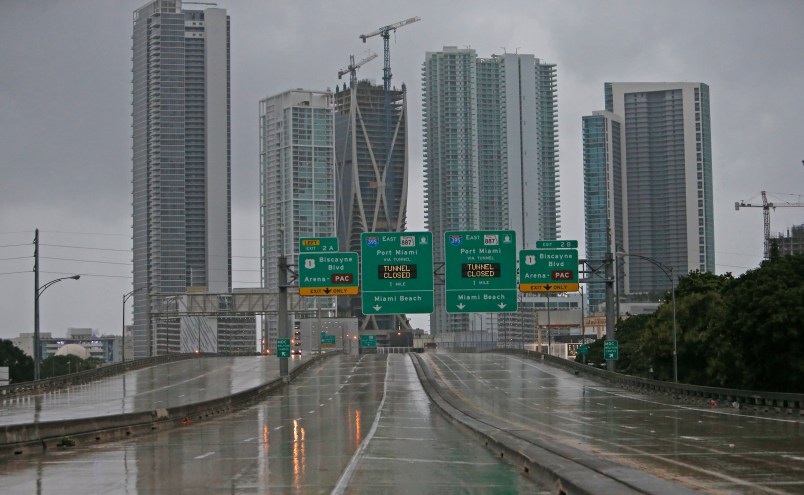MIAMI (AP) — With the window closing fast for anyone wanting to escape, Irma hurtled toward Florida with 125 mph winds Saturday on a shifting course that threatened the first direct hit on the Tampa area from a major hurricane in nearly a century.
That represented a significant turn in the forecast, which for days had made it look instead as if the Miami metropolitan area of 6 million people was going to get slammed head-on by the Big One.
“You don’t want to play with this thing,” Sen. Marco Rubio warned during a visit to the Miami-Dade Emergency Operations Center. “People will die from this.”
Forecasters predicted Irma’s center would blow ashore Sunday in the perilously low-lying Florida Keys, then hit southwestern Florida, move up the state’s Gulf Coast and plow into the Tampa Bay area.
The storm center itself is expected to miss Miami, but the metro area will still get pounded with life-threatening hurricane winds, National Hurricane Center spokesman Dennis Feltgen said.
Tampa has not been struck by a major hurricane since 1921, when its population was about 10,000, Feltgen said. Now the area has around 3 million people and encompasses two of Florida’s biggest cities: Tampa and St. Petersburg.
As the storm closed in on the Sunshine State, it pounded Cuba and left more than 20 people dead in its wake across the Caribbean after ravaging such resort islands as St. Martin, St. Barts, St. Thomas, Barbuda and Antigua.
Irma weakened slightly in the morning but was expected to pick up strength again before slamming Florida.
On Saturday morning, the hurricane’s outer bands blew into South Florida as residents scrambled to leave. Damaging winds were moving into areas including Key Biscayne and Coral Gables, and gusts up to 56 mph (90 kph) were reported off Miami.
In one of the biggest evacuations ever ordered in the U.S., about 6.3 million people in Florida — more than one-quarter of the state’s population — were warned to leave, and 540,000 were directed to clear out from the Georgia coast. Authorities opened hundreds of shelters for people who did not leave. Hotels as far away as Atlanta filled up with evacuees.
“If you are planning to leave and do not leave tonight, you will have to ride out this extremely dangerous storm at your own risk,” Florida Gov. Rick Scott said Friday. He urged everybody in the Keys to get out.
In St. Petersburg, people woke to the news that the storm had turned.
Nadier Yazoub, a 30-year-old firefighter, planned to board up his home and get his pregnant wife to safety. “I didn’t think we would get hit like that. I thought it would stick to the east coast,” he said.
Major tourist attractions, including the Disney World parks, Universal Studios and Sea World, all prepared to close Saturday. The Miami and Fort Lauderdale airports shut down, and those in Orlando and Tampa planned to do the same later in the day.
With winds that peaked at 185 mph (300 kph), Irma was once the most powerful hurricane ever recorded in the open Atlantic. But given its mammoth size and strength and its projected course, it could still prove one of the most devastating hurricanes ever to hit Florida and could inflict damage on a scale not seen here in 25 years.
It could also test the Federal Emergency Management Agency’s ability to handle two crises at the same time. FEMA is still dealing with aftermath of catastrophic Hurricane Harvey in the Houston area.
Ray Scarborough and girlfriend Leah Etmanczyk left their home in Big Pine Key and fled north with her parents and three big dogs to stay with relatives in Orlando. Scarborough was 12 when Hurricane Andrew hit in 1992 and remembers lying on the floor in a hallway as the storm nearly ripped the roof off his house.
“They said this one is going to be bigger than Andrew. When they told me that, that’s all I needed to hear,” said Scarborough, now a 37-year-old boat captain. “That one tore everything apart.”
Gas shortages and gridlock plagued the evacuations, turning normally simple trips into tests of will. Parts of interstates 75 and 95 north were bumper-to-bumper, while very few cars drove in the southbound lanes.
In suburban Palm Beach County on the state’s Atlantic coast, the streets were nearly deserted early Saturday as the first squall from Irma dropped a brief shower over the area. Gas stations ran out of fuel, grocery stores were closed and only a few fast-food restaurants were open.
Sherry Whiteside, a Palm Beach Gardens mental health counselor, had come to her neighborhood Publix because she was craving a cherry pie. The store was closed. She held out hope for the state.
“I am praying that it will somehow disintegrate or — what’s that word? — dissipate,” she said.
Andrew razed Miami’s suburbs with winds topping 165 mph (265 kph), damaging or blowing apart over 125,000 homes. Almost all mobile homes in its path were obliterated. The damage in Florida totaled $26 billion and at least 40 people.
___
Galofaro reported from Orlando. Associated Press writers Seth Borenstein in Washington; Terry Spencer in Palm Beach County; Gary Fineout in Tallahassee, Terrance Harris in Orlando; and Jason Dearen and David Fischer in Miami contributed to this report.
___
HURRICANE NEWSLETTER — Get the best of the AP’s all-formats reporting on Irma and Harvey in your inbox: http://apne.ws/ahYQGtb



